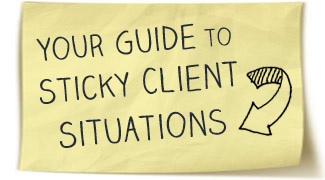
Here’s a brand new tricycle, honey! Have fun!
You would never give one of your children a trike and then send them off on their merry way.
And I wouldn’t do that to you, especially with something as important and complicated as social media marketing.
We talked last week about figuring out what is the best social media platform for your personality and your business. And all of the platforms we went over are very different—hence the need to find the one that works best for you.
But while some work better with short, frequent posts, others with images, and others with long, in-depth insights, there are some things they all share.
No matter what your platform, follow these five steps and you will find your audience and grow your business through social media marketing.
1. Study Before You Start
Let’s say that you have been a graphic designer for 10 years. You know a lot about the business, and have decided that it’s time to start coaching others who are just starting out.
You could just dive in, announce to anyone who will listen that you are offering coaching now, and figure it out as you go along, but you’ll have more clients, more effective sessions, and earn more money if you take a little time to talk to other coaches or study other coaching businesses first to see how they operate.
The same is true for social media marketing.
Now that you’ve chosen the first platform you are going to rock, use search or suggestions to find some people on that platform in your business area and do some analysis:
- How often do they post?
- What times of day do they post?
- How long are their posts?
- Do they use images? How?
- How many new followers do they get a day?
- Do they schedule posts? About what percentage?
- Do they participate in platform events like chats or Google hangouts?
- Do they interact primarily with prospects or other people with similar blogs or businesses?
2. Plan Your Posts
Planning social media posts is different than scheduling, which we’ll get to later (mostly because you have to learn how to do it right before you try to do it on autopilot!).
In the same way that you should have a calendar of some sort for your business marketing and blog posts (if you have a blog) to take into account your goals, holidays, and important events in your field, your social media posts will be most effective if you take the time to plan them by time and type and tweak that plan as you go along.
A simple spreadsheet or even a graph paper page in your planner or notebook is all you need. Mark out:
- How often you are going to post
- What type of post should go in each time slot (questions, inspiration, sharing other’s content, etc.)
- What time (approximately) these posts should go out
- If they should include links and images and where to find those pieces
3. Interact Like a Person
Though a decent portion of the social media that you post will end up being scheduled—to take advantage of optimal times and create a consistent stream throughout the day—social media marketing is, first and foremost, about person-to-person interaction.
Instagram and Facebook revolve around commenting on other people’s posts. Twitter can practically look like an instant messaging app at certain times of day. The power of pinterest is less in the images you post and more in the images from others that you pin.
Split your daily (or weekly) social media time roughly evenly between creating posts yourself and interacting with social media updates shared by others. And in every interaction, even if your social media account is connected to your brand not your own name, be authentic, helpful and kind.
4. Tackle Your Targets
Social media users are now such a huge sea that it can be difficult and sometimes a little terrifying to swim around with all the other species while you’re trying to find the school of fish that you belong to.
The best way not only to find the users you need to interact with but also make sure that you can keep finding them and interacting with them on a daily basis is through lists. Twitter, for instance, allows you to create lists, so that you can quickly and easily only see and interact with the people you want to focus on, rather than your entire stream. Twitter also allows you to see and copy other people’s lists.
In any network, however, it’s important to pick a core group of 5-10 users that you want to focus on interacting with in a given week or month to build relationships and reap the most benefits from your social media time.
5. Keep it Consistent
Though it’s important to spend some live time on your social media platform of choice to interact with others, we’re all pressed for time, and no one excepts you to be there 24/7.
Your core updates, the ones that you plan and put time into crafting can and should be scheduled in advance to ensure they reach your audience at an optimal time.
These days, there are simply so, so many ways to schedule your social media updates that it’s become more a matter of taste than utility:
- Need to manage multiple accounts, searches and hashtags at once? Hootsuite
- Prefer a clean interface with impressive photo tools? Buffer
- Need to keep old updates catalogued and categorized for easy recycling? Edgar
Bonus: Have Fun!
As I mentioned earlier, social media is first and foremost about person-to-person interaction.
If you aren’t enjoying your social media marketing, chances are it’s not making a big impact on others as well. Stick with what works best for you.
Have you come across other key principles for rocking social media marketing?





